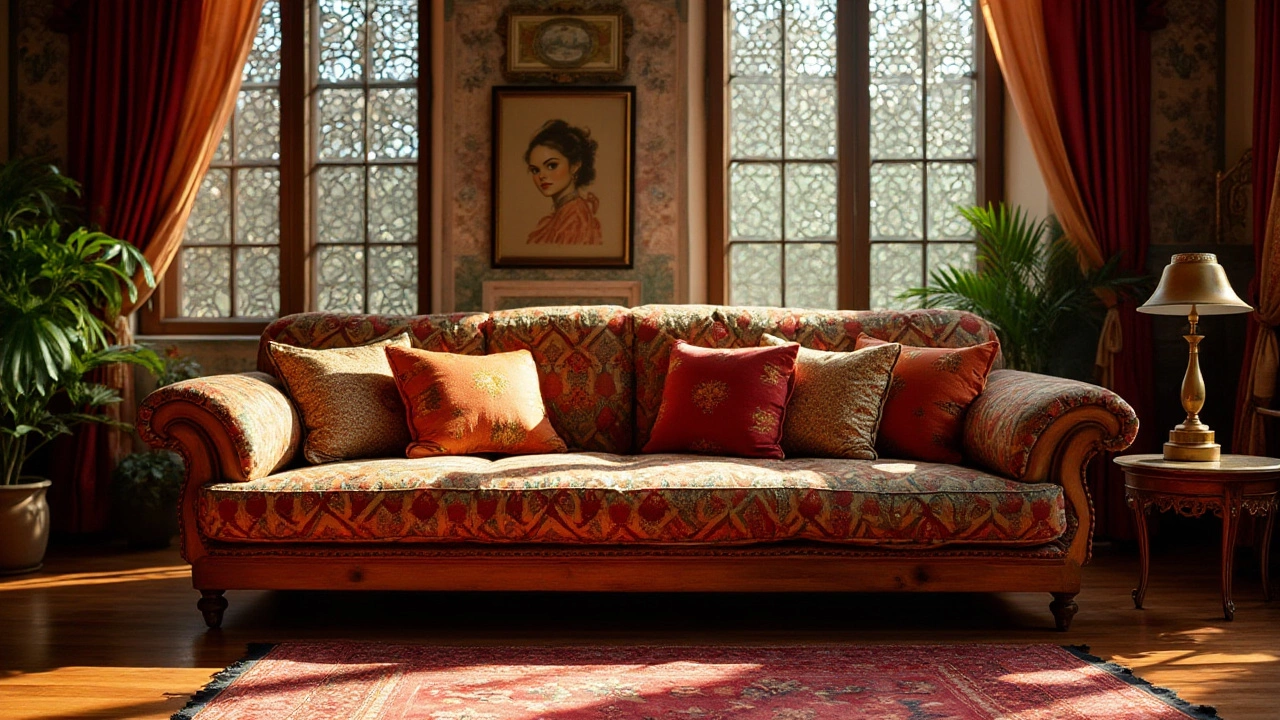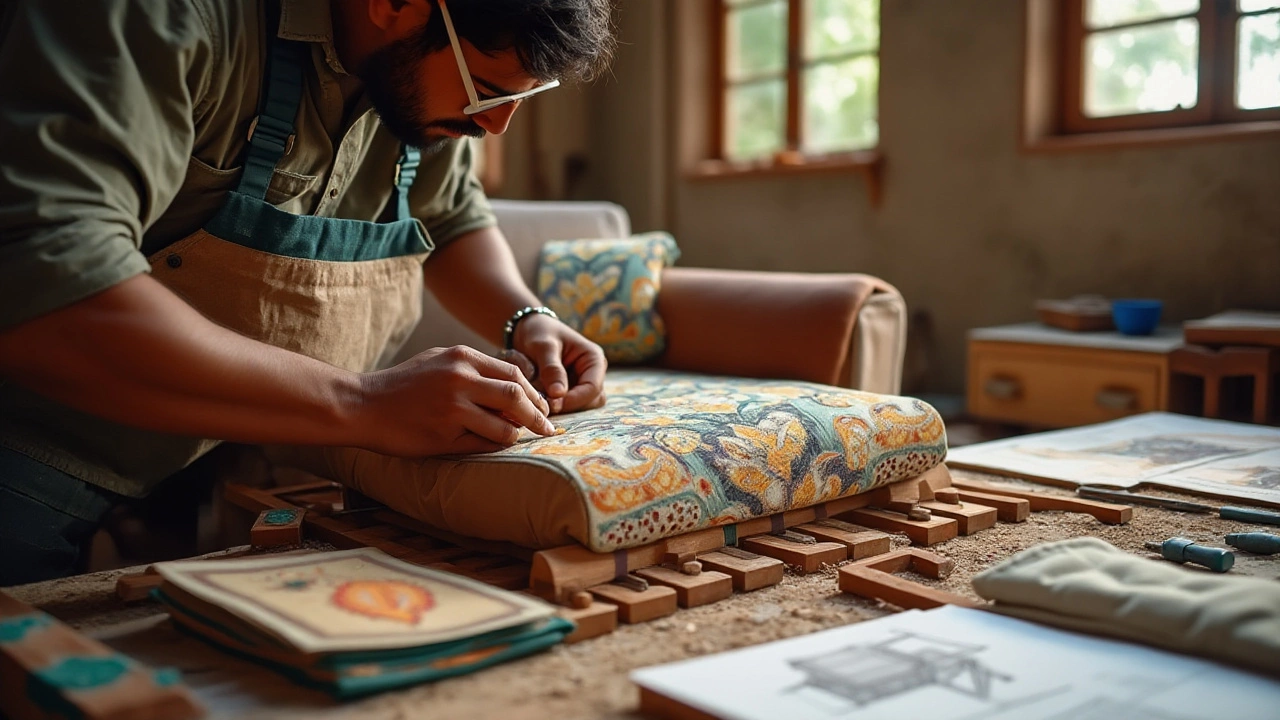Discover the Sofa Built to Endure

Imagine settling into your sofa, only to discover two years later it's sagging like an old hammock. Yikes! Nobody wants that, so selecting the right couch is crucial. Knowing the materials and craftsmanship behind a sofa might just save you future headaches—and backaches.
Finding a durable sofa isn't just about picking something robust but understanding what goes into building a resilient piece of furniture. From the framework to the fabric, each component plays a part in ensuring your chosen seat doesn't crumble under the pressure of time. Let's dive into what makes a sofa stand the test of time, and keep you comfy year after year.
- The Heart of Durability: Frame Construction
- Fabric and Upholstery: The Skin That Shields
- Cushions and Filling: Comfort That Endures
- Design and Maintenance: Tips for Longevity
The Heart of Durability: Frame Construction
When it comes to finding a durable sofa, the frame is the backbone of the piece. It's the silent supporter, and much like a building foundation, it must be strong to ensure longevity. There are various materials used in crafting frames, and not all are created equal.
Wooden Frames: The Timeless Classic
Solid hardwoods, such as oak, ash, or beech, are the gold standard in sofa frame construction. These woods are renowned for their robustness and resistance to warping over time. Sofas featuring kiln-dried hardwood frames are particularly durable, as the drying process removes moisture, preventing future distortion.
Pine and other softwoods, while less expensive, don't typically offer the same longevity. However, a pine frame can still be a reliable choice if you're looking for budget-friendly options, just be prepared for a shorter lifespan compared to hardwood.
Alternative Materials: Metal and Engineered Wood
Metal frames, often used in modern and minimalist designs, can equally provide solid support. These are particularly prevalent in sleek, industrial-style sofas. While engineered wood or particleboard might feature in more economical sofas, they shouldn't be a buyer's first choice if durability is the goal.
Understanding Joints: The Bind That Lasts
The way the frame is joined also plays a critical role in sofa durability. Interlocking joints such as dovetails or dowels, often including corner blocks glued and screwed into place, offer substantial strength. Alternatively, beware of staples or nails as the primary fasteners, which typically result in a cheaper, less durable frame.
Quick Tips for Assessing Frame Quality:
- Lift one front corner; if the opposite corner lifts easily, the frame is likely sturdy.
- Check for creaking or movement in the joints when pressure is applied.
- Ask about the materials and construction methods used before purchase.
Remember, a well-constructed frame can beautifully carry a sofa through years of everyday wear. Making a smart choice now ensures you won't be back at the store sooner than you'd desire, hunting for yet another seat that promises to withstand life's adventures and then some.
| Material | Pros | Cons |
|---|---|---|
| Oak, Ash, Beech | Long-lasting, resistant to warping | Higher cost |
| Pine | More affordable | Softer wood, less durable over time |
| Metal | Sleek design, industrial strength | Can be heavy, may rust |
Fabric and Upholstery: The Skin That Shields
When it comes to sofas, think of the upholstery as its suit of armor intricately designed to face daily challenges. Whether it's a playful pup or an accidental morning coffee spill, the right fabric ensures your durable sofa maintains its grace under pressure.
The Fabric Family: What's in a Material?
The choice of fabric heavily influences how long your couch will last. Materials like leather, microfiber, and certain natural fibers stand out for their resilience.
- Leather: Known for its toughness and classic appeal, leather develops a beautiful patina over time. It's easy to clean, though it requires conditioning to prevent dryness.
- Microfiber: This synthetic option offers a soft touch with strength. Microfiber repels dirt and moisture, making it ideal for households with kids or pets.
- Natural Fibers: Options like linen or cotton breathe well, but may require special attention to prevent wear. A blend with synthetics can enhance durability.
Patterns and Colors: More Than Meets the Eye
The right pattern or color does more than please the eye. Darker shades and busy patterns can deftly hide stains and wear, extending the couch's fresh appearance.
Upholstery Weaves: The Hidden Strength
The weave of the fabric is another crucial factor. Tight weaves typically indicate better durability. Look for high thread count options for improved longevity.
Durability Ratings: The Double Rub Test
When shopping, consider the fabric's double rub count, a test mimicking wear from sitting or getting up from a sofa. Fabrics with over 15,000 double rubs are suitable for everyday use.
| Fabric Type | Double Rubs | Durability Level |
|---|---|---|
| Residential Use (Light) | 10,000-15,000 | Moderate |
| Residential Use (Heavy) | 15,000+ | High |
| Commercial Use | 30,000+ | Extra High |
By understanding these elements, the quest for a long-lasting couch becomes straightforward. Choose your sofa's skin wisely; after all, it's the first line of defense in your battle for longevity.

Cushions and Filling: Comfort That Endures
A sofa's lifespan hinges not only on its structure but also on the comfort and integrity provided by its cushions and filling. This might seem secondary, but these are what give the seat its inviting plushness and prolonged stability.
The Core Elements of Sofa Cushions
When assessing cushion filling, several core elements come to mind—density, resilience, and longevity. High-density foam is a popular choice for its balance of support and softness, ensuring your sofa's cushions don’t lose shape after just a few lively game nights or marathon movie sessions. Look for foam with a density of around 1.8 to 2.5 pounds per cubic foot; this ensures durability without sacrificing comfort.
Natural and Synthetic Blend
Often, cushions come with a blend of foam and down, or sometimes polyester fibers for those who prefer something less expensive. While down provides luxurious softness, it requires regular fluffing to maintain its form. A blend of foam wrapped in a down or polyester layer offers the best of both worlds, increasing the durability and softness simultaneously.
Choosing Between Options
- Memory foam: Offers excellent comfort and support, yet can be too warm and less breathable in summer months.
- Latex foam: Known for its resilience and eco-friendliness, latex is a go-to for those with allergies as it is dust mite resistant.
- Polyester fiber: More budget-friendly yet less durable, having a shorter lifespan in terms of keeping its shape.
In addition to filling, paying attention to the way cushions are constructed and secured to the sofa can prolong their life. Detached cushions may be flipped and rotated, exposing less wear and evening out pressure.
Table: Cushion Longevity Comparison Chart
| Type | Estimated Lifespan |
|---|---|
| High-Density Foam | 5-8 Years |
| Memory Foam | 4-6 Years |
| Latex Foam | 7-10 Years |
| Polyester Fiber | 1-3 Years |
Ultimately, choosing the right cushion filling involves considering your comfort preferences, budget, and how often you expect your sofa to be in the spotlight of daily activity. Remember, the unsung hero of your beloved couch might just be what's inside those cushions, ensuring comfort that endures each passing year.
Design and Maintenance: Tips for Longevity
The secret to any long-lasting furniture piece often lies in both its design and how it’s maintained. A well-considered design not only enhances aesthetics but also contributes to the structural integrity of your durable sofa. Let’s explore the essential design considerations and top maintenance tips that keep your beloved couch looking and feeling new for years.
Smart Design Choices
When selecting a sofa, opting for a classic design over a trendy one might seem boring, but it's your best bet for the long haul. Timeless styles are not only easier to fit into evolving home interiors but are often constructed with better craftsmanship, leaving you with a stronger, more long-lasting couch.
Consider the proportions of the sofa fit for your space. Overstretched or overcrowded designs can put unnecessary stress on joints and fabrics, ultimately compromising sofa durability.
Selecting the Right Materials
Materials matter significantly in a sofa’s longevity. When it comes to the frame, hardwoods like oak, maple, and birch are preferred materials. They hold up better than softer woods or engineered options. Sturdy couches often come with metal reinforcements, an excellent choice for extra durability.
For fabrics, consider natural leathers and high-thread-count textiles. These materials age gracefully and can handle everyday wear and tear surprisingly well.
Maintenance Mastery
Even the highest quality sofa requires proper maintenance to ensure it maintains its charm and condition. Regular cleaning is paramount. Vacuum your sofa often to rid it of dust and dirt, which can wear down fabric fibers over time. Spot-clean spills immediately, since lingering stains can lead to permanent damage.
Use Slipcovers
If you want to keep your sofa pristine, slipcovers serve as a fantastic protective layer. They are especially helpful in homes with kids or pets, offering an easily washable barrier against spills and messes.
| Maintenance Task | Frequency |
|---|---|
| Vacuum | Weekly |
| Spot Clean | As Needed |
| Professional Deep Clean | Yearly |
Smart Placement
Where you position your sofa matters too. Avoid placing it in direct sunlight; this can fade and weaken fabric fibers. If sunlight is unavoidable, consider UV-protective window treatments or treating your sofa with sunscreen-type sprays designed for indoor fabrics.
Rotating Cushions
Remember to rotate cushions regularly to ensure even wear across all surfaces. This practice helps in maintaining their shape and can dramatically extend their lifespan.
By being mindful of the design elements and adhering to regular maintenance routines, your sofa will remain a stunning staple in your home décor and provide an enduring comfort oasis for years to come.